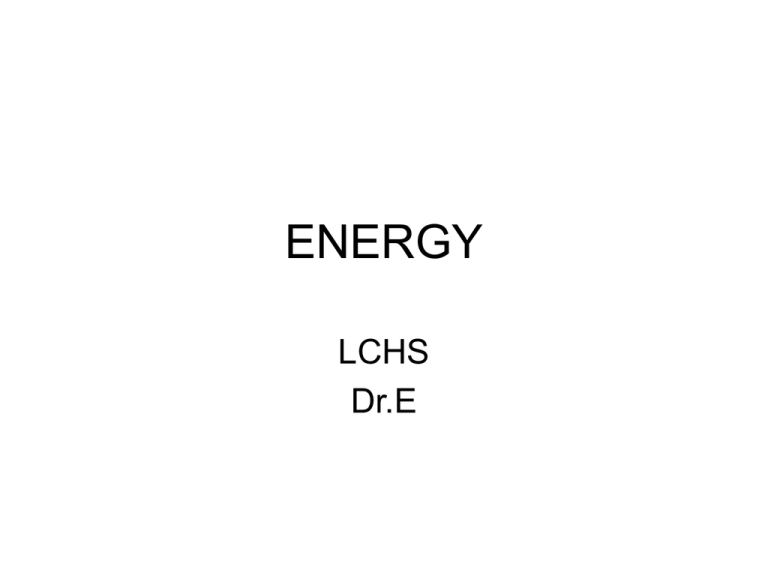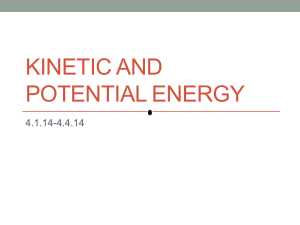Physics Review #1
advertisement

ENERGY LCHS Dr.E An egg is dropped from a third-story window. The distance the egg falls from the window to the ground is closest to 0 10 (A) m 1 (B) 10 m 2 (C) 10 m 3 (D) 10 m Which body is in equilibrium? (A) a satellite orbiting Earth in a circular orbit (B) a ball falling freely toward the surface of Earth (C) a car moving with a constant speed along a straight, level road (D) a projectile at the highest point in its trajectory Work A student does 60 joules of work pushing a 3.0-kilogram box up the full length of a ramp that is 5.0 meters long. What is the magnitude of the force applied to the box to do this work? (A) 20 N (B) 15 N (C) 12 N (D) 4.0 N Which combination of fundamental units can be used to express energy? (A) kg•m/s (B) kg•m2/s (C) kg•m/s2 (D) kg•m2/s2 A boy pushes his wagon at constant speed along a level sidewalk. The graph represents the relationship between the horizontal force exerted by the boy and the distance the wagon moves. What is the total work done by the boy in pushing the wagon 4.0 meters? (A) 5.0 J (B) 7.5 J (C) 120 J (D) 180 J The diagram shows points A, B, and C at or near Earth’s surface. As a mass is moved from A to B, 100 joules of work are done against gravity. What is the amount of work done against gravity as an identical mass is moved from A to C? (A) 100 J (B) 173 J (C) 200 J (D) 273 J Kinetic Energy A 75-kilogram bicyclist coasts down a hill at a constant speed of 12 meters per second. What is the kinetic energy of the bicyclist? (A) 4.5 × 102 J (B) 9.0 × 102 J (C) 5.4 × 103 J (D) 1.1 × 104 J The kinetic energy of a 980kilogram race car traveling at 90. meters per second is approximately 4 A. 4.4 × 10 J 4 B. 8.8 × 10 J C. 4.0 × 106 J D. 7.9 × 106 J If the speed of a car is doubled, the kinetic energy of the car is (A) quadrupled (B) quartered (C) doubled (D) halved A 60.0-kilogram runner has 1920 joules of kinetic energy. At what speed is she running? (A) 5.66 m/s (B) 8.00 m/s (C) 32.0 m/s (D) 64.0 m/s A 1-kilogram rock is dropped from a cliff 90 meters high. After falling 20 meters, the kinetic energy of the rock is approximately (A) 20 J (B) 200 J (C) 700 J (D) 900 J A 15.0-kilogram mass is moving at 7.50 meters per second on a horizontal, frictionless surface. What is the total work that must be done on the mass to increase its speed to 11.5 meters per second? (A) 120 J (B) 422 J (C) 570 J (D) 992 J Potential Energy The gravitational potential energy, with respect to Earth, that is possessed by an object is dependent on the object’s (A) acceleration (B) momentum (C) position (D) speed The diagram represents a 155-N box on a ramp. Applied force F causes the box to slide from point A to point B. What is the total amount of gravitational potential energy gained by the box? (A) 28.4 J (B) 279 J (C) 868 J (D) 2740 J A 60-kg student climbs a ladder a vertical distance of 4.0 meters in 8.0 seconds. Approximately how much total work is done against gravity by the student during the climb? (A) 2.4 × 103 J (B) 2.9 × 102 J (C) 2.4 × 102 J (D) 3.0 × 101 J While riding a chairlift, a 55-kg skier is raised a vertical distance of 370 meters. What is the total change in the skier’s gravitational potential energy? (A) 5.4 × 101 J (B) 5.4 × 102 J (C) 2.0 × 104 J (D) 2.0 × 105 J The work done on a slingshot is 40.0 joules to pull back a 0.10-kg stone. If the slingshot projects the stone straight up in the air, what is the maximum height to which the stone will rise? (A) 0.41 m (B) 41 m (C) 410 m (D) 4.1 m What is the gravitational potential energy with respect to the surface of the water of a 75.0-kg diver located 3.00 m above the water? 4 2.1710 (A) J 3 (B) 2.2110 J 2 (C) 2.2510 J 1 (D) 2.2910 J A spring with a spring constant of 4.0 N/m is compressed by a force of 1.2 N. What is the total elastic potential energy stored in this compressed spring? A. 0.18 J B. 0.36 J C. 0.60 J D. 4.8 J A spring has a spring constant of 25 N/m. The minimum force required to stretch the spring 0.25 meter from its equilibrium position is approximately -4 A. 1.0 × 10 N B. 0.78 N C. 6.3 N D. 1.0 × 102 N A vertical spring 0.100 meters long is elongated to a length of 0.119 meters when a 1.00-kilogram mass is attached to the bottom of the spring. The spring constant of this spring is A. 9.8 N/m B. 82 N/m C. 98 N/m D. 520 N/m A 3.0-kilogram mass is attached to a spring having a spring constant of 30. N/m. The mass is pulled 0.20 m from the spring's equilibrium position and released. What is the maximum kinetic energy achieved by the mass spring system? A. 2.4 J B. 1.5 J C. 1.2 J D. 0.60 J Power A boat weighing 9.0 × 102 Newtons requires a horizontal force of 6.0 × 102 Newtons to move it across the water at 1.5 × 101 meters per second. The boat’s engine must provide energy at the rate of (A) 2.5 × 10–2 J (B) 4.0 × 101 W (C) 7.5 × 103 J (D) 9.0 × 103 W What is the maximum amount of work that a 6000-watt motor can do in 10 seconds? (A) 6.0 × 101 J (B) 6.0 × 102 J (C) 6.0 × 103 J (D) 6.0 × 104 J A 70-kg cyclist develops 210 Watts of power while pedaling at a constant velocity of 7.0 m/s east. What average force is exerted eastward on the bicycle to maintain this constant speed? (A) 490 N (B) 30 N (C) 3.0 N (D) 0 N A small electric motor is used to lift a 0.50-kilogram mass at constant speed. If the mass is lifted a vertical distance of 1.5 meters in 5.0 seconds, the average power developed by the motor is (A) 0.15 W (B) 1.5 W (C) 3.8 W (D) 7.5 W Conservation of Energy As a ball falls freely toward the ground, its total mechanical energy (A) decreases (B) increases (C) remains the same A boy pushes his wagon at constant speed along a level sidewalk. The graph represents the relationship between the horizontal force exerted by the boy and the distance the wagon moves. As the boy pushes the wagon, what happens to the wagon’s energy? (A) Gravitational potential energy increases. (B) Gravitational potential energy decreases. (C) Internal energy increases. (D) Internal energy decreases. A ball is dropped from the top of a cliff. Which graph best represents the relationship between the ball’s total energy and elapsed time as the ball falls to the ground? [Neglect friction.] An object is thrown upward. Which pair of graphs best represents the object’s kinetic energy and gravitational potential energy as functions of its displacement while it rises? A child, starting from rest at the top of a playground slide, reaches a speed of 7.0 meters per second at the bottom of the slide. What is the vertical height of the slide? [Neglect friction.] (A) 0.71 m (B) 1.4 m (C) 2.5 m (D) 3.5 m A car travels at constant speed v up a hill from point A to point B. As the car travels from A to B, its gravitational potential energy (A) increases and its kinetic energy decreases (B) increases and its kinetic energy remains the same (C) remains the same and its kinetic energy decreases (D) remains and its kinetic energy remains the same Efficiency A 45.0-kg boy is riding a 15.0-kg bicycle with a speed of 8.00 m/s. What is the combined kinetic energy of the boy and the bicycle? A. 240. J B. 480. J C. 1440 J D. 1920 J If the kinetic energy of the boy and the bicycle is 1920 J and is 90% efficient, how work or energy must the boy use to pedal the bike? While riding a chairlift, a 55-kg skier is raised a vertical distance of 370 m. What is the total change in the skier’s gravitational potential energy? A. 5.4 × 101J B. 5.4 × 102 J C. 2.0 × 104 J 5 D. 2.0 × 10 J If the total change in the skier’s gravitational potential energy is 2.0 × 105 J, and there is 6.0 × 105 J added by the machinery, what is the efficiency of the ski lift?






